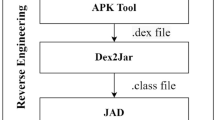Abstract—
The use of clustering algorithms to determine the types of malicious software files based on the analysis of the WinAPI function call sequences is investigated. The use of clustering algorithms such as k-means, EM-algorithm, hierarchical algorithm, and the affinity propagation method is considered. The quality of clustering is evaluated using the silhouette metrics, the Calinski–Harabasz index, and the Davies–Bouldin index.






Similar content being viewed by others
REFERENCES
Hu, X., et al., Mutant x-s: Scalable malware clustering based on static features, 2013 USENIX Annual Technical Conference, 2013, pp. 187–198.
Oprişa, C., Cabău, G., and Pal, G.S., Malware clustering using suffix trees, J. Comput. Virol. Hacking Tech., 2016, vol. 12, no. 1, pp. 1–10.
Altaher, A., et al., Malware detection based on evolving clustering method for classification, Sci. Res. Essays, 2012, vol. 7, no. 22, pp. 2031–2036.
Shishkin, N.V., Matskevich, E.E., and Kozachok, A.V., A malware detection algorithm based on analysis of malware behavior, Inf. Bezop., 2012, vol. 15, no. 3, pp. 353–360.
Pai, S., A comparison of clustering techniques for malware analysis, Master’s Project, San Jose State University, 2015.
Wicherski, G., peHash: A novel approach to fast malware clustering, LEET, 2009, vol. 9, p. 8.
Giannella, C. and Bloedorn, E., Spectral malware behavior clustering, 2015 IEEE International Conference on Intelligence and Security Informatics (ISI), 2015, pp. 7–12.
Cuckoo Sandbox. https://cuckoosandbox.org/.
VirusShare. https://virusshare.com/.
Coates, A. and Ng, A.Y., Learning feature representations with k-means, in Neural Networks: Tricks of the Trade, Berlin–Heidelberg: Springer, 2012, pp. 561–580.
Xiaojin Zhu, The EM Algorithm, University of Wisconsin, 2007. http://pages.cs.wisc.edu/~jerryzhu/ cs761/em.pdf.
Frey, B.J. and Dueck, D., Clustering by passing messages between data points, Science, 2007, vol. 315, no. 5814, pp. 972–976.
Chen, G., et al., Evaluation and comparison of clustering algorithms in analyzing ES cell gene expression data, Stat. Sin., 2002, pp. 241–262.
Davies, D.L. and Bouldin, D.W., A cluster separation measure, IEEE Trans. Pattern Anal. Mach. Intell., 1979, no. 2, pp. 224–227.
Caliński, T. and Harabasz, J., A dendrite method for cluster analysis, Commun. Stat. Theory Methods, 1974, vol. 3, no. 1, pp. 1–27.
Author information
Authors and Affiliations
Corresponding authors
Ethics declarations
The authors declare that they have no conflicts of interest.
Additional information
Translated by I. P. Obrezanova
About this article
Cite this article
Ognev, R.A., Zhukovskii, E.V. & Zegzhda, D.P. Clustering of Malicious Executable Files Based on the Sequence Analysis of System Calls. Aut. Control Comp. Sci. 53, 1045–1055 (2019). https://doi.org/10.3103/S0146411619080212
Received:
Revised:
Accepted:
Published:
Issue Date:
DOI: https://doi.org/10.3103/S0146411619080212




